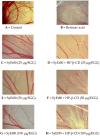The Anti-Angiogenic Effect of Cynara cardunculus L. subsp. cardunculus Waste Product
- PMID: 40807592
- PMCID: PMC12346066
- DOI: 10.3390/foods14152656
The Anti-Angiogenic Effect of Cynara cardunculus L. subsp. cardunculus Waste Product
Abstract
Cynara cardunculus L. subsp. cardunculus (Cynara cardunculus L. var. sylvestris (Lam.) Fiori), the wild cardoon, is known for its culinary applications and potential health benefits. Due to this, and given the growing interest in circular economies, deepening our under-standing of the effects of wild cardoon leaf waste on angiogenesis and collagenase activity represents a valuable opportunity to valorise agricultural byproducts as health-promoting ingredients. In this study, the waste product of wild cardoon leaves was extracted to examine its chemical composition and biological activities. Analytical techniques identified several bioactive compounds, including flavonoids, hydroxycinnamic acids such as dicaffeoyl-succinoylquinic acids, and luteolin-7-O-rutinoside. In vivo tests in zebrafish embryos and the chick chorioallantoic membrane demonstrated dose-dependent antiangiogenic effects, particularly enhanced by the complexation with hydroxypropyl-β-cyclodextrin (HP-β-CD). Considering the link between angiogenesis and collagenase, the potential effects of the extract on collagenase activity was investigated. The extract alone inhibited collagenase with an IC50 value comparable to that of the standard inhibitor while its complexed form exhibited a 4.5-fold greater inhibitory activity. A molecular docking study examined the interaction between the main compounds and collagenase. In conclusion, wild cardoon leaves can represent a valuable source of bioactive compounds. This study demonstrated that the complexation of the extract with cyclodextrin determines an increase in its biological activity.
Keywords: angiogenesis; chick chorioallantoic membrane; collagenase; hydroxypropyl-β-cyclodextrin; wild cardoon; zebrafish.
Conflict of interest statement
The authors declare no conflicts of interest.
Figures







Similar articles
-
Prescription of Controlled Substances: Benefits and Risks.2025 Jul 6. In: StatPearls [Internet]. Treasure Island (FL): StatPearls Publishing; 2025 Jan–. 2025 Jul 6. In: StatPearls [Internet]. Treasure Island (FL): StatPearls Publishing; 2025 Jan–. PMID: 30726003 Free Books & Documents.
-
Extension of Poultry Meat Shelf Life Using Cynara cardunculus L. Leaf Extracts as a Natural Preservative.Foods. 2025 Jul 24;14(15):2592. doi: 10.3390/foods14152592. Foods. 2025. PMID: 40807529 Free PMC article.
-
Chemical composition and in vitro biological activities of cardoon (Cynara cardunculus L. var. altilis DC.) seeds as influenced by viability.Food Chem. 2020 Sep 1;323:126838. doi: 10.1016/j.foodchem.2020.126838. Epub 2020 Apr 16. Food Chem. 2020. PMID: 32334313
-
Management of urinary stones by experts in stone disease (ESD 2025).Arch Ital Urol Androl. 2025 Jun 30;97(2):14085. doi: 10.4081/aiua.2025.14085. Epub 2025 Jun 30. Arch Ital Urol Androl. 2025. PMID: 40583613 Review.
-
Signs and symptoms to determine if a patient presenting in primary care or hospital outpatient settings has COVID-19.Cochrane Database Syst Rev. 2022 May 20;5(5):CD013665. doi: 10.1002/14651858.CD013665.pub3. Cochrane Database Syst Rev. 2022. PMID: 35593186 Free PMC article.
References
-
- Fernandes F., Delerue-Matos C., Grosso C. Unveiling the potential of agrifood by-products: A comprehensive review of phytochemicals, bioactivities and industrial applications. Waste Biomass Valoriz. 2025;16:2715–2748. doi: 10.1007/s12649-024-02622-0. - DOI
-
- Amoriello T., Mellara F., Ruggeri S., Ciorba R., Ceccarelli D., Ciccoritti R. Artichoke by-products valorization for phenols-enriched fresh egg pasta: A sustainable food design project. Sustainability. 2022;14:14778. doi: 10.3390/su142214778. - DOI
-
- Cravero V., Martin E., Crippa I., López Anido F., García S.M., Cointry E. Fresh biomass production and partitioning of aboveground growth in the three botanical varieties of Cynara cardunculus L. Ind. Crops Prod. 2012;37:253–258. doi: 10.1016/j.indcrop.2011.12.028. - DOI
Grants and funding
LinkOut - more resources
Full Text Sources
Research Materials
Miscellaneous

